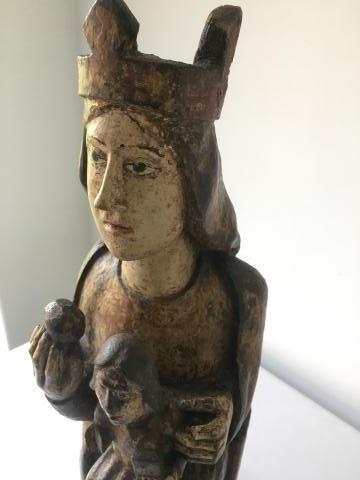Art on Campus of Tilburg University
One of the first artworks the institution acquired—in the early 1960s—was a so-called Sedes Sapientiae - or Seat of Wisdom.

That description refers to Mary, seated on a throne with Jesus as a child on her lap. He carries both a globe (as a symbol of God's dominion over creation) and a book (sign of his function as a teacher). That purchase refers to the institution's Catholic origins.
Since then, the university has purchased and commissioned various works, especially for the exterior spaces and the more representative areas in the buildings. Commissions have also been given to artists to design a university medal or corporate gift.
Quite a few works of art have been donated to the university or given on permanent loan—by alumni and emeriti, for example.
Overview of artworks on campus
University Art Committee
The University Art Committee is responsible for commissions, purchases, bequests, and management of the art collection. In recent years, the emphasis in the choices has been on the photography genre, an art form that, like the university, has a relatively young history. The Committee always looks for a good connection to university themes, to the specific buildings where a work will be displayed, or to the identity of the institution.
The Committee also regularly collaborates with the Tilburg Textiel Lab for the production of tapestries that are made with extremely modern techniques and special fabrics. For example, in the Auditorium there is a 'woven picture' by Teun Hocks, entitled Understanding Society—the motto of the university.
Many of the artists whose work the university holds are also represented in museum collections.
Art loan via the internal art library
Much of the university collection can be found in the internal art library (intranet). University employees can borrow work there for their office, hallway, or meeting space.
More about the arts policy and the Arts Committee
Tilburg University attaches great importance to the environment in which students and employees perform their work. For this reason, much attention is paid to the architecture of the buildings and the design of the public space. The university campus has a green, landscape-like character in which a modest number of artworks can be found. The sculptures sometimes form an orientation point, at other times a refuges, and also a strong contrast. This is the case, for example, with the black, granite sculpture by André Volten in the courtyard garden between the Cobbenhagen and Koopmans Buildings, which consists of only a few simple mathematical forms.
Quite a few of the works in the outdoor area have the relationship between nature and culture as their subject, sometimes quite literally, sometimes abstractly. For many artists, the classic adage Natura Artis Magistra—nature as the teacher of the arts, which includes science—still applies. The works of art on the campus thus serve not only to beautify but also to reflect.
The university's art policy is adopted by the Executive Board and is implemented by an Art Committee composed of staff and some specialists.
The Committee supervises commissions for new buildings and renovations, is responsible for purchases (often contemporary photography) or donations of works, and organizes several smaller exhibitions each year. The Committee is also responsible for the university's art library, which also houses the management of the artworks.
The Committee advises and supports the Executive Board, Schools and Divisions in this area.
More about history and academic heritage
The Tilburg University academic heritage is a very diverse set of archives, visual materials, collections, devices, recorded stories, et cetera that relate to the history of the university.
